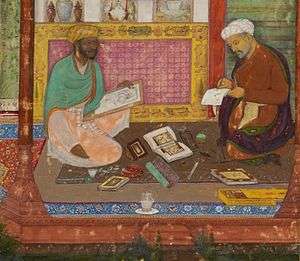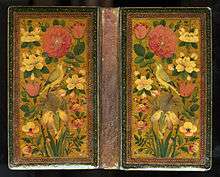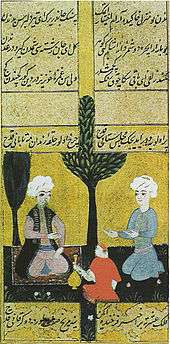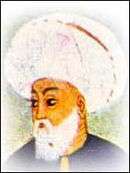Diwan (poetry)
In Islamic cultures of the Middle East, North Africa, Sicily[1] and South Asia, a Diwan (Persian: دیوان, divân, Arabic: ديوان, dīwān) is a collection of poems by one author, usually excluding his or her long poems (mathnawī).[2] These poems, frequently sung or set to music, were often composed and collected in the imperial courts of various sultanates and were very well known for their ability to inspire. In modern-times, the inspirational, linguistic, verse, meter, and other design features of the Diwan or Masnavi poetry, are found echoing in other cultures, same or similar to the relaying of hidden messages, safety, and support, left for those ex-slaves on the Underground Railroad, during the American Civil War. Thus, Themes That emerge from traditional Islamic origins can again portray of and evoke the persistence of life, or whatever continuances, admirable to the old or traditional ways and wisdoms. Where these are found in freeform variants, like an enigma, the modern Diwan, as powers brings a peculiar message encompassing for the divinities.

Etymology
The English usage of the phrase "diwan poetry" comes from the Arabic word diwan (دیوان), which is loaned from Persian, and designated a list or register.[3] The Persian word derived from the Persian dibir meaning writer or scribe. Diwan was also borrowed into Armenian, Arabic, Urdu, Turkish.[2] In Persian, Turkish and other languages the term diwan came to mean a collection of poems by a single author, as in selected works, or the whole body of work of a poet. Thus Diwan-e Mir would be the Collected works of Mir Taqi Mir and so on. The first use of the term in this sense is attributed to Rudaki.
The term divan was used in titles of poetic works in French, beginning in 1697,[3] but was a rare and didactic usage, though one that was revived by its famous appearance in Goethe's West–östlicher Divan (Poems of West and East), a work published in 1819 that reflected the poet's abiding interest in Middle Eastern and specifically Persian literature.
This word has also been applied in a similar way to collections of Hebrew poetry and to poetry of al-Andalus.
Symbolism

Ottoman Divan poetry was a highly ritualized and symbolic art form. From the Persian poetry that largely inspired it, it inherited a wealth of symbols whose meanings and interrelationships—both of similitude (مراعات نظير mura'ât-i nazîr / تناسب tenâsüb) and opposition (تضاد tezâd)—were more or less prescribed. Examples of prevalent symbols that, to some extent, oppose one another include, among others:
- the nightingale (بلبل bülbül) – the rose (ﮔل gül)
- the world (جهان cihan; عالم ‘âlem) – the rosegarden (ﮔﻠﺴﺘﺎن gülistan; ﮔﻠﺸﻦ gülşen)
- the ascetic (زاهد zâhid) – the dervish (درويش derviş)
As the opposition of "the ascetic" and "the dervish" suggests, Divan poetry—much like Turkish folk poetry—was heavily influenced by Sufi thought. One of the primary characteristics of Divan poetry, however—as of the Persian poetry before it—was its mingling of the mystical Sufi element with a profane and even erotic element. Thus, the pairing of "the nightingale" and "the rose" simultaneously suggests two different relationships:
- the relationship between the fervent lover ("the nightingale") and the inconstant beloved ("the rose")
- the relationship between the individual Sufi practitioner (who is often characterized in Sufism as a lover) and God (who is considered the ultimate source and object of love)
Similarly, "the world" refers simultaneously to the physical world and to this physical world considered as the abode of sorrow and impermanence, while "the rosegarden" refers simultaneously to a literal garden and to the garden of Paradise. "The nightingale", or suffering lover, is often seen as situated—both literally and figuratively—in "the world", while "the rose", or beloved, is seen as being in "the rosegarden".[4]
Divan poetry was composed through the constant juxtaposition of many such images within a strict metrical framework, thus allowing numerous potential meanings to emerge. A brief example is the following line of verse, or mısra (مصراع), by the 18th-century judge and poet Hayatî Efendi:
- بر گل مى وار بو گلشن ﻋالمدﻪ خارسز
- Bir gül mü var bu gülşen-i ‘âlemde hârsız[5]
- ("Does any rose, in this rosegarden world, lack thorns?")
Here, the nightingale is only implied (as being the poet/lover), while the rose, or beloved, is shown to be capable of inflicting pain with its thorns (خار hâr). The world, as a result, is seen as having both positive aspects (it is a rosegarden, and thus analogous to the garden of Paradise) and negative aspects (it is a rosegarden full of thorns, and thus different from the garden of Paradise).
Development

As for the development of Divan poetry over the more than 500 years of its existence, that is—as the Ottomanist Walter G. Andrews points out—a study still in its infancy;[6] clearly defined movements and periods have not yet been decided upon. Early in the history of the tradition, the Persian influence was very strong, but this was mitigated somewhat through the influence of poets such as the Azerbaijani Imadaddin Nasimi (?–1417?) and the Uyghur Ali-Shir Nava'i (1441–1501), both of whom offered strong arguments for the poetic status of the Turkic languages as against the much-venerated Persian. Partly as a result of such arguments, Divan poetry in its strongest period—from the 16th to the 18th centuries—came to display a unique balance of Persian and Turkish elements, until the Persian influence began to predominate again in the early 19th century.
Despite the lack of certainty regarding the stylistic movements and periods of Divan poetry, however, certain highly different styles are clear enough, and can perhaps be seen as exemplified by certain poets:

- Fuzûlî (1483?–1556); a unique poet who wrote with equal skill in Azeri Turkish,[7] Persian, and Arabic, and who came to be as influential in Persian as in Divan poetry
- Bâkî (1526–1600); a poet of great rhetorical power and linguistic subtlety whose skill in using the pre-established tropes of the Divan tradition is quite representative of the poetry in the time of Süleyman the Magnificent
- Nef‘î (1570?–1635); a poet considered the master of the kasîde (a kind of panegyric), as well as being known for his harshly satirical poems, which led to his execution
- Nâbî (1642–1712); a poet who wrote a number of socially oriented poems critical of the stagnation period of Ottoman history
- Nedîm (1681?–1730); a revolutionary poet of the Tulip Era of Ottoman history, who infused the rather élite and abstruse language of Divan poetry with numerous simpler, populist elements
- Şeyh Gâlib (1757–1799); a poet of the Mevlevî Sufi order whose work is considered the culmination of the highly complex so-called "Indian style" (سبك هندى sebk-i hindî)
The vast majority of Divan poetry was lyric in nature: either gazels (which make up the greatest part of the repertoire of the tradition), or kasîdes. There were, however, other common genres, most particularly the mesnevî, a kind of verse romance and thus a variety of narrative poetry; the two most notable examples of this form are the Layla and Majnun (ليلى و مجنون) of Fuzûlî and the Hüsn ü Aşk (حسن و عشق; "Beauty and Love") of Şeyh Gâlib.
Urdu variation
In Urdu poetry diwan are also a collection of poems, but here they are mainly ghazals.[8]
Modern (freeform) variation
During the American Civil War, the Freedom Quilts, bore well known patterns, and codes that signaled to slaves they should begin to prepare for their journey North, in pursuit of freedom. Symbols such as the Wagon Wheel (pack for the journey), dress up (Shoofly), and get ready to escape (Tumbling Blocks), were stitched into the quilts that draped as an alert, to those fugitive slaves with no other way out. Of these, the Bear's Pau, was a common or otherwise familiar symbol for those who needed safety, food, and shelter, and suggested that a slave was no longer to be treated as if, or like Animals. There was a way forward by the Star, and even a Log Cabin, sometimes not much more than a shanty, or black box, by their side, always and forever, as post.[9] Recently, the modern use or freeform variant, is stylistically present in the D-I-V-I-N-I-T-A-S puzzle, also dubbed Sorokin's enigma.
Seen here, in a 3-page multi-layered, visual and textual quilt, the anonymous bearer has combined, eloquently, the thrust of a translated Masnavi verse bridging the oldest and most beautiful language,Telugu, with our most versatile of modern languages, English. The underlying syntactical creation, or question as parable by it, does not hide the unwinding of ancient Eastern and Islamic themes of Peace, Love, and balance, found in the way of a diamond, for what is both seamlessly, as bound by implication, playing out through contemplative interconnectedness.[10] Like the slaves, making their way up north, the path taken from page-to-page, or by a whirl, can hold little without what markings, from a time to time, what are not one bit indulgent, but quite necessary to see or use, for the in-between. The mystery of whether this modern puzzle takes us directly to necessary clues or answers to the Shugborough Shepherd's Monument, in Staffordshire, England, or from there to Antiquity, and back again, then suggests that in Eastern thinking, and Islamic cultural traditions, persist an overabundance of invitation: to see what we already have, right now, in tow, by ancient languages or law. What tales of the tape "ones-ones" swims or forbears, are appreciably 1-1-1-1 or in Taenias. Where bade expressions, or syntax are null-and-void, if not outdated, herein-our-motives-evolve, tho' not too much or to amass, giving forth the times for all divinities. In the D-I-V-I-N-I-T-A-S, "They arne well worn, between the hems, as seen, what hears from any bugle of garments 'tween, trumpeting their bloom, in a song-like tune, B-C-B-A-G-F♯-G-A, the unfolding of time's peri-winkle, gay, that winks at you in a patch-worked rule, not just from Ol' Britannia, but back and forth, intuitively, sublime thinkings. That lasting Fourths, shall bear and mend ... How long before I'II see the end? [11](anonymous source, the poets-longest Divan Club-guest-in-law*).
See also
- Anthology
- Arabic literature
- Early Modern literature
- Poetic meter of Ottoman Turkish
- Ottoman divan poets (Category)
- Persian literature
- Mathnawi (poetic form)
References
- Meri, Josef W.; Bacharach, Jere L. (2006-01-01). Medieval Islamic Civilization: A–K, index. Taylor & Francis. ISBN 9780415966917.
- Blois, François de (2011). "DĪVĀN". Encyclopædia Iranica.
- Alain Rey et al., Dictionnaire historique de la langue française, new ed. (Robert, 1995), vol. 1, p. 617.
- Andrews, Walter G.; Kalpaklı, Mehmet (2005). The age of beloveds : love and the beloved in early-modern Ottoman and European culture and society (2nd ed.). Durham: Duke University Press. ISBN 0-8223-3424-0.
- Pala, İskender (1995) Divân Şiiri Antolojisi: Dîvânü'd-Devâvîn Akçağ Yayınları, Kızılay, Ankara, p. 425, ISBN 975-338-081-X
- Andrews, Walter G.; Black, Najaat; Kalpaklı, Mehmet (2011). Ottoman Lyric Poetry: An Anthology. University of Washington Press. pp. 22–23. ISBN 9780295800936.
- Rollberg, Peter (1987). Harry Butler Weber (ed.). The Modern Encyclopedia of Russian and Soviet Literature (including Non-Russian and Emigre literatures). 8. Academic International Press. p. 76.
In Mesopotamia Fuzuli was in intimate contact with three cultures – Turkic, Arabic, and Persian. Besides his native Azeri, he learned Arabic and Persian at an early age and acquired a through command of the literatures in all three languages, an accomplishment in which the cosmopolitan literary and scholarly circles of Hilla played an important role.
- A History of Urdu literature by T. Grahame Bailey; Introduction
- "Mathwire.com | Freedom Quilts". mathwire.com. Retrieved 2020-08-01.
- Laufer, Berthold (1917). The Diamond: A Study in Chinese and Hellenistic Folk-lore. Field Museum of Natural History.
- Cyphus, Dion (2019-02-21), English: the D-I-V-I-N-I-T-A-S puzzle also known as Sorokin's Enigma, for the reasonableness, of Merci. (PDF), retrieved 2020-08-01
Further reading
- Clinton, Jerome W. (1989). "Bolbol "nightingale" – In Persian Literature". Encyclopædia Iranica.
- Diba, Layla S. (2001). "Gol O Bolbol". Encyclopædia Iranica.
External links
- Many examples of Ottoman Divan poetry, in Turkish, from Internet Archive
- Divan – Full Text – Republic of Turkey Ministry of Culture and Tourism, in Turkish